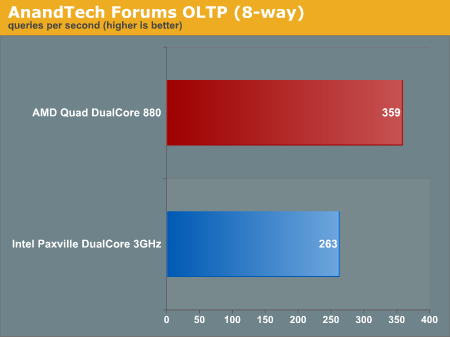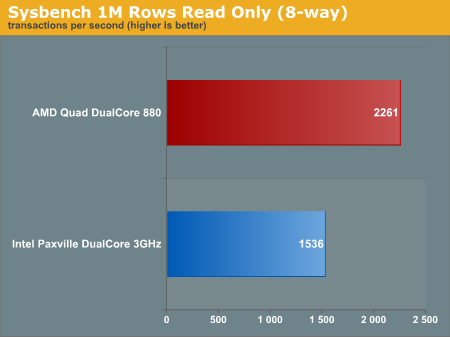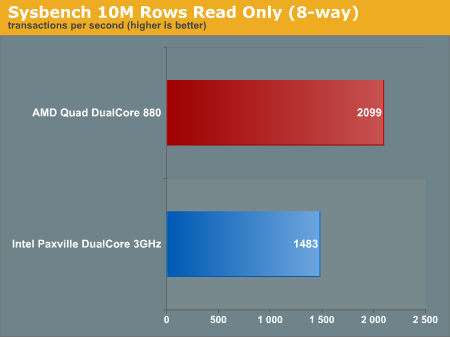Eight Core Servers: Opteron 880 (Egypt) vs. Xeon MP 3.0 GHz (Paxville)
by Jason Clark on April 24, 2006 2:00 AM EST- Posted in
- IT Computing
Benchmark Results
The Opteron leads the way in every test, which isn't surprising. As we've said in the past the current Xeon is hindered by the front-side bus. Trying to shove a giant beach ball into a basket ball hoop - with thirty other people waiting to try the same thing - has a serious impact on scalability. All of the tests are fairly consistent, and the Opteron averages a 36-51% lead over the Paxville system.

The forum test represents a medium workload OLTP application, and the Opteron comes out ahead by approximately 36%.




Opteron averages anywhere from 40-51% over Paxville during this test, representative of a medium workload OLTP application.
The Opteron leads the way in every test, which isn't surprising. As we've said in the past the current Xeon is hindered by the front-side bus. Trying to shove a giant beach ball into a basket ball hoop - with thirty other people waiting to try the same thing - has a serious impact on scalability. All of the tests are fairly consistent, and the Opteron averages a 36-51% lead over the Paxville system.

The forum test represents a medium workload OLTP application, and the Opteron comes out ahead by approximately 36%.




Opteron averages anywhere from 40-51% over Paxville during this test, representative of a medium workload OLTP application.










35 Comments
View All Comments
coldpower27 - Monday, April 24, 2006 - link
At least then by the time you do replace your machines hopefully Intel will be more competitive in this spaceAnemone - Monday, April 24, 2006 - link
Honestly it doesn't hurt to bring the point home again and again about Opteron. Those making buying decisions who are still stuck on Intel only solutions need the truth laid out for them regularly and repeatedly, imo. Thank you for doing that, because the current Intel solutions are a waste of money, and I hate that the most of all.:)
johnzo - Monday, April 24, 2006 - link
Are your test result comments correct? ie DVD Store Test, should the AMD lead be 40% not 29% ?AMD has 8853 more orders, which is 40% more than 21782.The same error (?) goes for the other percentages mentioned.
If I am wrong please forgive somebody with an old brain !
Jason Clark - Monday, April 24, 2006 - link
You are correct, my mistake. This is fixed.psychobriggsy - Monday, April 24, 2006 - link
Right, using funky-maths, if a 2.6GHz Conroe is 20% faster than a 2.8GHz X2.And this 8-core 2.6GHz (?) Opteron system is 40% faster than a 3GHz 8-core Xeon.
And the issue is scalability, i.e., the same problem will exist for Woodcrest.
However Woodcrest will be 3GHz, but this will only be useful for cache-bound tasks because of the scalability problems (expect all the Intel biased websites to only benchmark Woodcrest with this type of task). Maybe Opteron will be dual-core 3GHz by then...
Anyway I can't conclude anything without making huge vast leaps of guesswork, but yes, it will be very close later this year, but if Woodcrest can't beat Opteron because of the platform limitations then there will be little to no incentive to switch back from buying Opteron based servers to Intel based servers (for the companies that have switched to AMD), apart from power consumption.
However it means Intel will stop losing customers to AMD in the server space, if the performance and power consumption issues are addressed. By no means do I see AMD losing much of their gained marketshare however (and by Q4 it will be higher than now I'm sure).
peternelson - Monday, April 24, 2006 - link
If power consumption is your concern, then AMD offer reduced power versions of Opteron chips (eg the HE models) at increased cost. When they can migrate to 65nm process, we should see even better power economy.
Furen - Monday, April 24, 2006 - link
Here's what I think will happen. AMD will get a run for its money on the single-socket and dual-socket arenas (since dual-FSB pretty much keeps the FSB from being too limiting) but once you scale higher AMD will once again rule the roost. I also think that quad-core will be better on AMD's architecture, too, since throwing 4 Conroe/Woodcrest cores on a single FSB (266MHz I'd expect, though I suppose it could be 333) will give these cores a huge performance hit, more so in MP configurations (just thinking about the cache-coherency traffic for 8 cores scares me)coldpower27 - Monday, April 24, 2006 - link
Maybe, but it's hard to say at this point, how low FSB speed will affect Core Architecture, plus this is the Xeon MP space, where it won't be transistioning to Core Architecture for sometime until Q1 2007 earliest from what I believe with the Clovertown MP/Tigerton Core, I don't think there is a Woodcrest equivalent for this space.I expect AMD to have the "FSB" advantage in 4-8 way situations yes, however this may or may not translate to a performance crown for AMD.
Thoug I think it's pretty safe for Intel that they can take back the Xeon DP space with Woodcrest, and DIB.
JarredWalton - Monday, April 24, 2006 - link
I think you need to remember a couple of things. First, Woodcrest is based off of the next-generation Core architecture. Power and performance characteristics will be completely different from the current NetBurst chips. Second, Woodcrest will also have a 1333 MHz front side bus -- twice as fast as the server benchmarked here. Finally, and I could be wrong on this, but I think Intel is looking at one shared front side bus for every two sockets, and they could potentially move to one front side bus for each socket.That last idea would make sense for quad-core. And speaking of quad core, that's such a significant change that again it's almost impossible to predict at this stage. I mean, we don't even really know how AMD or Intel are going to build their quad core packages. Are we talking a single die, or will they have multiple dice on a package? Will Intel change the way the dice communicate with each other?
Of course, none of this things means that Intel will come out on top, but there are enough significant changes that we can't declare a victor at this point. Also, large L3 caches can indeed help server work. Otherwise, why would IBM even make a POWER5 chip with 128 MB of L3 cache? Adding tons of cache to a desktop system rarely helps, but enterprise servers are completely different beast.
At the very least, things should get interesting later this year. :-)
Furen - Monday, April 24, 2006 - link
You are indeed correct.In the DVD store test the AMD system is indeed 40% faster than the Intel system, but the Intel system is 30% slower than the AMD one. He seems to have chosen the AMD scores as the reference but incorrectly says that AMD is 30% faster instead of saying that Intel is 30% slower.